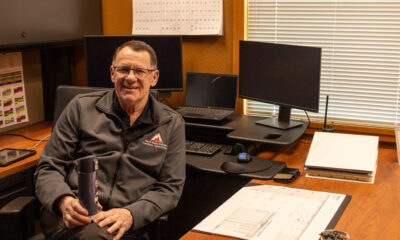Perspectives
Back it up, with Blu-Ray
One of the worst feelings in the world (particularly for students) is missing or corrupted files. Picture this. You have been working for the past 3 days on a lengthy essay or other type of assignment, and a power surge knocks your entire setup offline for a few seconds. You turn your computer back on, praying it is still there. You think to yourself that everything will be fine, as you diligently saved your work to your HDD or SSD every few hours. You wait for your machine to load, when suddenly, you get an error message (the message dependent upon the OS you run – Windows, MacOS, Linux, BSD, Tails, etc.) that tells you your drive is not responding. You take it to a computer repair shop, only for one of two options to occur. Either the drive is completely dead and there is nothing you can do about it (the worst option), or they can recover the data lost on it, to the tune of several hundred dollars.
This is a rather common experience. I have worked and volunteered in tech repair and recycling (e-waste) shops for a bit over 10 years now, and one of the most common issues we see has to do with power supply failures. Not just the PSU itself, but the effects a sudden or rapid supply of power does to a motherboard and all connected peripherals. The medium in which your data is stored is almost always at the mercy of the electricity it needs to draw to be powered and to work correctly. A power surge or even power deficiency can damage and oftentimes destroy your electronics.
Hard Drives are magnetic storage mediums. They store data by either magnetizing or demagnetizing billions of tiny ares on a platter (modern hard drives tend to have 9 or more of these platters), which creates the binary code that the other components of a Personal Computer needs to operate correctly. Hard Drives are susceptible to the components needed to operate itself functionally. This consists of the following:

- Actuator that moves the read-write arm. In older hard drives, the actuators were stepper motors. In most modern hard drives, voice coils are used instead. As their name suggests, these are simple electromagnets, working rather like the moving coils that make sounds in loudspeakers. They position the read-write arm more quickly, precisely, and reliably than stepper motors and are less sensitive to problems such as temperature variations.
- Read-write arm swings read-write head back and forth across platter.
- Central spindle allows platter to rotate at high speed.
- Magnetic platter stores information in binary form.
- Plug connections link hard drive to circuit board in personal computer.
- Read-write head is a tiny magnet on the end of the read-write arm.
- Circuit board on underside controls the flow of data to and from the platter.
- Flexible connector carries data from circuit board to read-write head and platter.
- Small spindle allows read-write arm to swing across platter.
SSDs are similar to HDDs when it comes to their vulnerability to power surges and power outages. Any deviation from the normal power flow is detrimental to the operations that are performed by either an SSD or HDD (and all other mediums of data storage – with the sole exception of already written data on an optical disk). Whereas a HDD has moving parts, an SSD doesn’t (necessarily). An SSD (Solid State Drive) tends to deteriorate with time, due to their NAND logic gates widening, which allows for less certainty, and eventually, the gates allow all electricity to pass through them.
Whereas HDDs have bearings and other mechanical parts that simply wear out, the issues that crop up with SSDs can be far more subtle, and oftentimes you won’t know it until it’s too late. There are other methods of data storage, though they tend to be expensive. While LTO (Linear Tape Open) is more affordable after several generations have elapsed since the current one (we are now on LTO9; and LTO5 and LTO6 are just now becoming more affordable for their tape readers), they tend to be far slower than Hard Drives and SSDs when it comes to accessing files, as the tape needs to be wound to the requested data. LTO, however, is also magnetic storage, which makes it susceptible to power surges or outages.
Other forms of flash memory are also expensive, and subject to degradation due to sitting on a shelf or not in use. Flash memory (like SSDs, SD Cards, MicroSD Cards, Flash Drives, etc.) is also more expensive, and will last you roughly the same amount of time as a HDD (assuming proper care of the HDD).
This is where Optical Media comes into play. Unlike Magnetic Storage mediums like HDDs, LTO, or Flash Storage mediums like SSDs or Flash Drives – Optical Media is not easily destroyed unless physically. While there are some optical media forms that you are able to write to more than once, your common CD-R, DVD-R, or BD-R will not be able to be written to once already written the first time. This alone makes the medium incredibly secure from power surges/outages, ransomeware attacks, as well as general incompetence (such as it falling; whereas if a HDD falls, you can kiss it goodbye).
The great thing about Optical Media is that once written to, you cannot delete it, or write to that same disc again. It is locked in place. That makes it perfect for backups, the storage of important files, and for data collections. Worried about ransomeware attacking your files? If stored on Optical Media, you won’t have to be, as there is no way for that ransomware to encrypt your files. Simply pull the disc from your computer, and factory reset your operating system.
While its true that you can drop kick the Optical Media and all your data will be intact (assuming you don’t scratch the disc (Blu Rays are notoriously harder to scratch than DVDs or CDs as their data layer in a more secure spot than the other aforementioned Optical Media)) the same can not be said for what is required to write and read the discs. The Burner/Reader is an amazing piece of technology, yet it still has moving parts. However, unlike the moving parts on a Hard Drive, you will not lose data once your burner/reader goes kaput. Replacing a burner/reader is on the affordable side, with internal 5.25 inch ones going for around $60 on Amazon. While it might be annoying to replace these when they do eventually die, you can rest assured knowing your data in intact.
What makes Blu-Ray discs the best choice over CDs or DVDs? To put it simply, their price per GB. A typical CD-R can hold 700MB of data, and a DVD-R can hold 4.7GB. Blu-Ray puts that to shame, with sizes ranging from 25GB to 128GB (with several other forms on the way). The cost difference is stark. While there are arguments to be had regarding cost vs. quality, in my own experience, a lot of the cheaper discs work just fine, and sometimes even better than the more expensive ones. While there is no replacing brands like Taiyo-Yuden, their competitors can be almost as good. One brand offered by Checkoutstore has been my go to for over a year now. Offering them as cheaply as 1,200 BD-R discs for $262, that equals out to just $8.73/TB. In my experience in burning over 1,500 of them (with another 800 ready to go), I have had less than a dozen coasters be made, with most of those being my own fault. In contrast, an 8TB external Hard Drive will run you $120 on sale at Costco, and a lot of those do not have the best recording mediums (SMR, PMR/CMR, etc.). Clearly, at this price point, Blu-Ray wins against Hard Drives, with the closest SSD competitor (4TB Samsung) costing as little as $350 on sale.
If you are into datahoarding, then I would suggest using BD-R. While it will take up more room to store those discs compared to drives or servers/NAS systems, I believe the benefits will suit you. Odds are most of the data you have is able to go into cold storage.
Storytime: This is my third main data collection. I had 191TB (full) with 222TB (RAW) during my first time, and deleted it because of a mental break I had. After taking several months of a break (having sold a good deal of those drives), the datahoarding bug caught me once again, and within 6 months I was at 161TB before I had another mental break. I convinced myself my efforts at attempting to preserve YouTube channels (many of them having been permanently deleted by then – as with my first collection), TV, Movies, Bitchute, eBooks, an entire rip of SciHub, and other content which I found to be culturally important. Long story short, I deleted everything (including over 10TB of personally recorded content of my family), sold my drives, and bought books with the money. I greatly regret both of these purges. This would not have happened had I stored my data on Blu-Ray to begin with. I could simply store it in the closet. The thing that convinced me to sell my drives instead of storing them in my closest was a mix of my extreme minimalism, what I would call a religious experience, as well as the money I would be able to gain from selling the drives.
I am now up to 49TB of full Discs (CDs, DVDs, and BDs) with 19TB RAW, and roughly 35TB of full Hard Drives with 16TB RAW. I am in the processing of selling the drives and burning that data over to disc. Nobody is able to say that I lack entertainment or things to watch/read/listen to.
Backing up your files doesn’t just have to be for school, it could also be those things which you hold dear. Perhaps it is a beloved family photo you have digitized, or a video of your friend’s funeral (RIP Leon “Gramps” Nichols), or even a silly YouTube video. Regardless of what it is, it is important you save your digital memories for years and decades to come. If this technology will still be around in several decades, your descendants will thank you for doing so, even if you think that content is mundane. Will they care how many times you called someone a racial slur in overwatch? Doubtful, but that will help to form a picture as to who you are, be it under pressure, or in easy times.
Hard Drives tend to last 3-7 years if they’re lucky. SSDs can be expected to last around the same time. LTO can last for a couple decades, but Blu-Ray discs are expected to last for 30+ years. While this will certainly NOT be the case for every disc you have (which is why you keep backups of your backups – the 3-2-1 method), it is nice to know that perhaps one day, you might be going through your old things, and come across an old disc with the entire second season of the Sopranos on DVD/BD, or a mix of random memes or other software/games you once loved. Only time will tell.


















